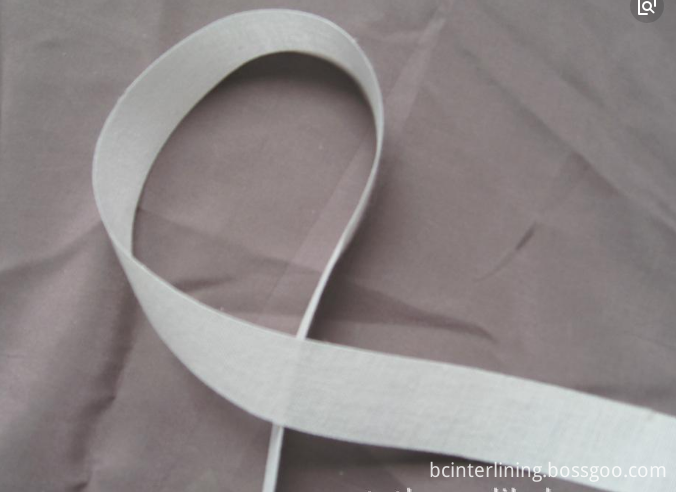Waist Interlining is a kind of woven interlining ,specially used in waist of the trousers and skirt . It can make the waist fabric hard ,skid resistance,and setting the pattern .
It can be cutted to strip ,maybe 20mm ,or 30mm or 50mm to fit the clothes size .
Waist Interlining Waist Interlining,Black Waist Interlining,Non Fusible Waist Interlining,TC Waist Interlining Baoding Garment Interlining Factory , http://www.bcinterlining.com
From the perspective of domestic demand, after the initial seasonal adjustment, in the third quarter of 2010, the textile industry’s product sales revenue was 735.17 billion yuan, an increase of 23.5% year-on-year, an increase of 11.8% from the previous quarter; and the apparel manufacturing industry sales revenue in the third quarter was 298.17 billion yuan, year-on-year. It grew by 19.0%, a 12.5% ​​increase from the previous quarter. Exports still maintain a strong momentum. After preliminary seasonal adjustments, the textile industry's exports in the third quarter of 2010 were US$57.35 billion, an increase of 29.1% year-on-year and an increase of 40.6% from the previous quarter, reaching a record high; in the third quarter, the value of apparel manufacturing exports was US$38.64 billion, an increase of 26.1% year-on-year. Return to the historical average growth level.
In the fourth quarter, the pressure on the textile and apparel industry continued to increase, mainly because of the continuous rise in the prices of raw materials. Affected by the increase in cotton prices, enterprises have purchased polyester staple fiber and viscose fiber products to replace cotton yarn for production, which has boosted the price of some chemical fiber products. The continued general rise in the prices of raw materials has pushed up the ex-factory prices of textile products in the first half of the year.
It is worth noting that the rising prices of raw materials such as cotton and chemical fiber played a significant role in promoting the profitability of the textile industry in the first half of the year. This is mainly because the ex-factory price of intermediate products has risen following the rise in raw materials, and the increase has exceeded that of raw materials, and profits have actually increased in the event of rising costs. Taking the yarn industry as an example, the cotton yarn industry achieved an increase of 16% in the first half of the year, and the growth rate has been around 10% since 2000. The China Textile Industry Climate Index also shows that the index of textile product prices in the first three quarters was located in the red signal zone. However, with the depletion of low-priced inventory materials purchased in the early stage, the raw materials newly purchased at high prices will reduce the profitability of textile companies. Therefore, after the boom of the cotton yarn industry has experienced a high point, it is more likely that growth will slow in the fourth quarter.
The increase in the cost of this round of raw material prices is mainly due to the end product manufacturing companies such as clothing, which have a certain time lag (usually about 6 months from raw materials to clothing). The impact of this round of rising raw material prices on the apparel industry began to show up in the third quarter, which was also the main reason for the slight decline in the profit margin of the garment industry in the third quarter. This trend will continue in the fourth quarter, and the total profit of apparel manufacturing companies in the fourth quarter may be further reduced.
Although the growth of the textile and apparel industry is facing greater pressure in the fourth quarter, in the long run, textile and apparel, as an important part of large consumption, will benefit from the “Twelfth Five-Year Plan†to expand domestic demand, improve people’s livelihood, and increase the income of residents. guide. At present, there is still a clear gap between urban and rural incomes. The per capita clothing expenditure in rural areas is only one-sixth that of urban residents. The overall increase in income of urban and rural residents, especially the income of middle- and low-income people, will The demand for textile products in the upper reaches of the industrial chain has increased significantly. In the long run, in the next five years, the domestic market for textile and apparel companies will have huge room for growth.
At present, for the textile and garment industry, adjusting the structure is still the subject of industry development. Some unfavorable factors in the short term have accelerated the transformation and upgrading of the industry, prompting enterprises to accelerate the pace of development on both sides of the smile curve, improve the front-end design and development level and the back-end brand marketing capabilities, and improve the profitability of enterprises by increasing the added value of products. This is also the only way to adjust the industrial structure. 
]WK~QNX%FD[C$9.png)
Textile industry: will enter the adjustment interval in the fourth quarter
According to the report of the textile and apparel industry climate index and related industry data, the economic conditions of the textile industry continued to improve in the third quarter, and the year-on-year growth rates of exports, employees, profits, and fixed asset investment increased at different levels. The economic index of the textile industry in the third quarter of 2010 was 101.0 points, an increase of 1.1 points from the previous quarter, showing signs of being hot. The economic prosperity index of China's garment industry was 99.1 points, which was basically the same as that of the previous quarter, and showed a certain downward trend. Overall, the economic performance of the textile industry is better than that of the apparel industry.